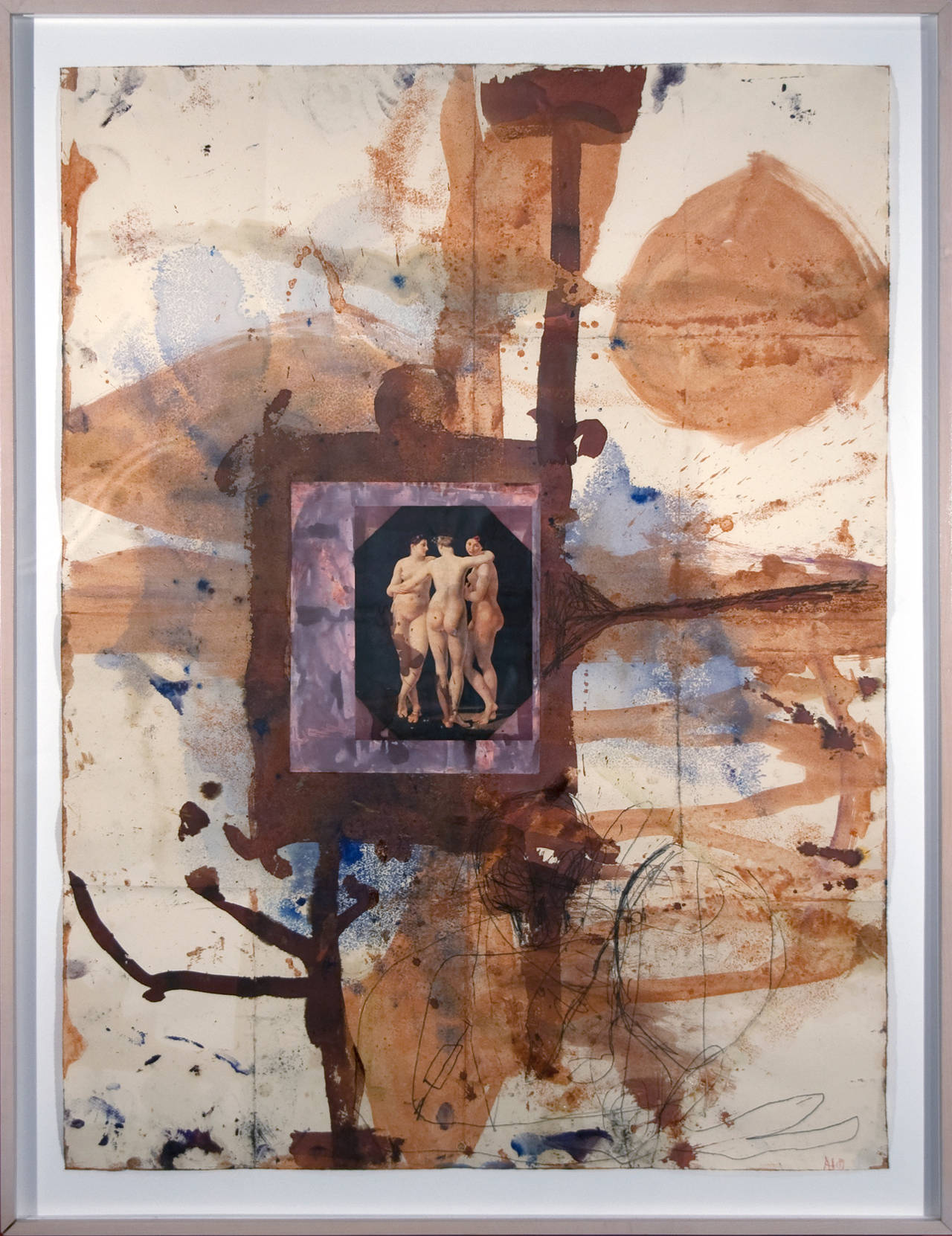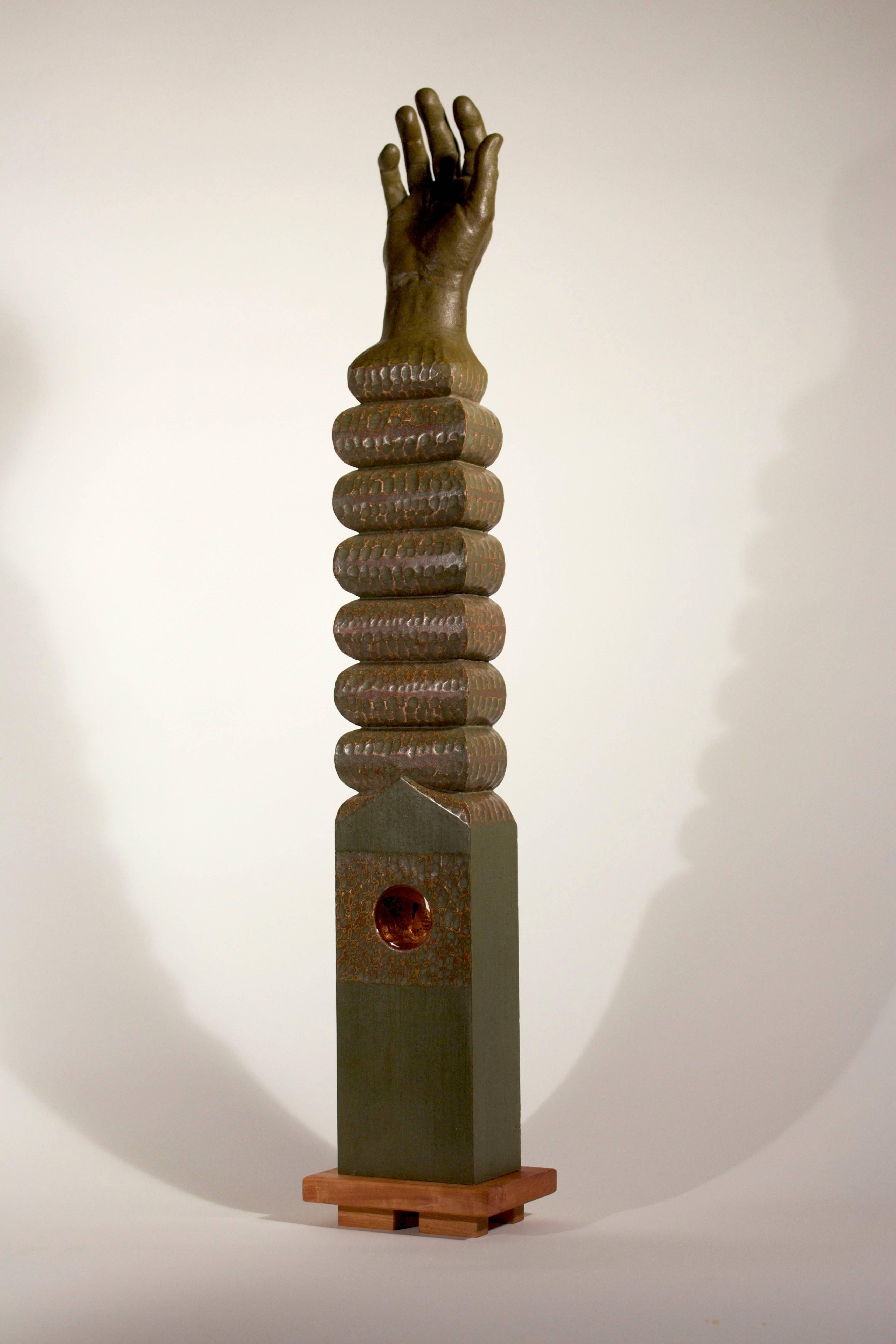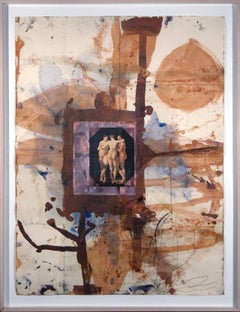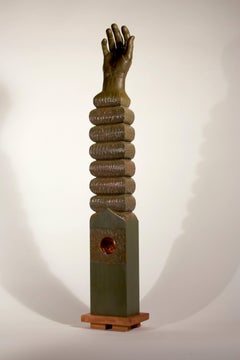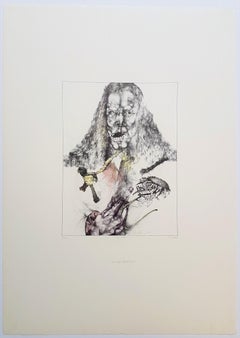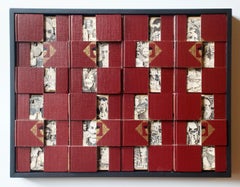Want more images or videos?
Request additional images or videos from the seller
1 of 6
Kurt KempTomc.1990
c.1990
$1,300
£994.74
€1,138.49
CA$1,835.94
A$1,995.35
CHF 1,069.33
MX$24,227.14
NOK 13,424.76
SEK 12,449.42
DKK 8,503.14
About the Item
This artwork titled "Tom" c.1990 is an intaglio with collage on paper by noted artist Kurt Kemp, b.1957. It is hand signed and titled in pencil by the artist. The image size is 11 x 10.25 inches, framed size is 32.75 x 25 inches. Custom framed in a wooden grey frame. It is in excellent condition, paper is slightly waved and have a very soft handling crease at left bottom, see picture #1
About the artist:
1984 M.F.A. Printmaking, University of Iowa
1983-85 Printer and studio assistant for Mauricio Lasansky
1981 M.A. Printmaking, University of Iowa
1979 B.A. Cum Laude, Marycrest College, Davenport, IA1990- Assistant Professor, Sonoma State University, Rohnert Park, CA
1993- Master Printer at Aurobora Press in San Francisco, CA
Fall 99 Visiting Artist, Carleton College, Northfield, MN
Fall 99 Visiting Artist, Univ. of Wisconsin at La Crosse, La Crosse WI
1989-90 Visiting Artist, Sonoma State University, CA
1985-89 Assistant Professor, University of Texas at El Paso
1984-85 Instructor, Printmaking, University of Iowa
1981-84 Teaching and Research assistant, Printmaking Dept., University of Iowa
SPECIAL HONOR
2011 Visiting Artist, San Francisco State University
2010 Visiting Artist, College of the Sequoias
Visiting Artist, Arrowmont School of Art
2009 Visiting Artist, Penland School of Arts and Crafts
Visiting Artist, Southeastern Louisiana University
2008 Visiting Artist, Arrowmont School of Art
Jurist, Hamblet Award, Vanderbilt University, Department of Art
2006 Visiting Artist and Jurist, Chico State University, Chico, CA
2004 Appointed Visiting Professor, University of Georgia, Cortona Campus, Cortona, Italy
1999 Appointed Dayton-Hudson Distinguished Artist Teacher Chair, Carleton College, Northfield, MN
SELECTED SOLO EXHIBITIONS
2011 Kurt Kemp: recent Work, Udinotti Gallery, Scottsdale, AZ
No Room to Breathe, Kurt Kemp and Chris Jehly, Lower Haters, San Francisco, CA
Pin Up, Kurt Kemp and Mark Perlman Collaborations, Aurobora Gallery, San Francisco, CA
2010-11 Living Wall, Kurt Kemp and Mark Perlman, Sonoma Valley Museum of Art, Sonoma, CA
2009 When a Black Heart Bleeds, Portland Community College, Sylvania Campus, Portland, OR
Kurt Kemp, Ten Year Survey, Center for the Print Gallery, Columbia University, New York, NY
2008 Dear Eliesa, Hooks-Epstein Galleries, Houston, TX
2007 Sad Circus (Where's My Twenty?), Collaborativr Print Exhibition with Mark Perlman, Aurobora Press, San Francisco, CA
2006 Irony and Allegory, Cumberland Gallery, Nashville, TN 2005 The Personal Politics, Davidson Gallery, Seattle, WA
2004 Intuitive Response, Clark Hall Gallery, Southeastern Louisiana University, Hammond, LA
2003 The Hen House Drawings, Hooks-Epstein Galleries, Houston, TX
Frogman Press & Gallery in conjunction with workshop and print made at University of South Dakota, Beresford, SD
2001 My Constellations, Hooks-Epstein Galleries, Houston, TX
2000 I Want to be James Ensor, Hooks-Epstein Galleries, Houston, TX
1999 New Town, Carleton College Gallery, Carleton College, NM
Mendicino College, Ukiah CA
The Drunken Boat - Exhibition of prints created for a book published by Auroboro Press in San Francisco containing five hand color prints is a book consisting of new translation of Arthur Rimbaud's The Drunken Boat (1999)
1998 Listening Table, Patricia Sweetow Gallery, San Francisco, CA
Inches Across Miles, California Museum of Art, Luther Burbank Center, Santa Rosa, CA
The Little Tongues that Tell You, Fine Arts Gallery, Pasadena City College, Pasadena, CA
The Drunken Boat, Sonoma Arts Council Gallery, Santa Rosa, CA
1997 Pages From a Bruised Book, Hooks-Epstein Galleries, Houston, TX
Patricia Sweetow Gallery Collaboration, San Francisco, CA
1996 Michael Himovitz Gallery, Sacramento, CA
1995 Escape, Hooks-Epstein Galleries, Houston, TX
Invited to create wine label for Benzinger Wines Artist Series/ Label used to create Corporate Poster/ 22 x 30"/ Full Color
Boston Printmakers Invitational, Bradley University, IL
U.S.A. Within Limits, Invitational/ Galeria Millan, Sao Paulo, Brazil
Longview Art Museum, Longview, TX
Stephen F. Austin State University, Nacogdoches, TX
Michael Himovitz Gallery, Sacramento, CA
1994 Inches Across Miles Across Me, Hooks-Epstein Galleries, Houston, TX 1993 Hooks-Epstein Galleries, Houston, TX
Michael Himovitz Gallery, Sacramento, CA
1992 Regarding My Humanity, Hooks-Epstein Galleries, Houston, TX 1991 Udinotti Gallery, San Francisco, CA
Himovitz Gallery, Sacramento, CA
1990 Hooks-Epstein Galleries, Houston, TX
Dartmouth College, Hanover, NH
SELECTED GROUP EXHIBITIONS
2011 Drawing the Line: From Process to Purpose, Arsenal Center for the Arts, Watertown, MA
Couples, Long Island Beach Island Foundation of the Arts and Sciences, Loveladies, NJ
2010 Then and Now, Contemporary Prints and Historical Perspectives, University of Minnesota, MN
Manifold, Austin Peay State University, TN
2009 Chico State University, Guest Artist, Monoprint Workshop
Small Packages, Cumberland Gallery, Nashville, TN
Crosiing the Line, New Perspectives in Drawing, Santa Rosa Junior College Art Gallery, Santa Rosa,CA
2008 Meeting the Other, American and Egyptian Prints, University of Nebraska, Lincoln, NB and El Miniya University, Egypt
Muse Among the Vines: Art from the North Bay Wine Country, Oakland International Airport, Oakland, CA
Frogman's Print and Paper Symposium, University of South Dakota
7th Janet Turner National Print Competition Exhibition, Chico State University
2007 New Works, Gerald Peters Gallery, Dallas, TX
Davidson Gallery, Seattle, WA
31: Thirty-one artists. Thirty-one works., Hooks-Epstein Galleries, Houston, TX
Paper Goods, Cumberland Gallery, Nashville, TN
Janet Turner National Print Exhibition, Janet Turner Museum, Chico, CA
2006 Beyond Printmaking, Texas Tech University, Lubbock, TX
CSU Printmaking Faculty/Student Exhibition, Chico State University, Chico, CA
California Printmakers, Visalia Art Center, Visalia, CA
Small Packages, Cumberland Gallery, Nashville, TN
2005 Faculty Exhibition, Frogman Press Workshop, University of South Dakota Art Gallery, Vermillion, SD
The True Artist, DiRosa Art Preserve, Napa, CA
USM Museum of Art, University of Southern Mississippi, Hattiesburg, MS
2004 Anatomically Incorrect, Off the Preserve, Napa, CA
Danger, University Art Gallery, Chico, CA
Outlaw Printmakers, Big Cat Gallery, New York, NY
2003 6 Contemporary American Printmakers, University of Connecticut, Storrs, CT
Taboo X, Fine Arts Academy, Pozan, Poland
Danger, L.H. Horton Gallery, Stockton, CA
Catfish Press Print Portfolio, Mississippi State University
Underfoot, Sao Paulo and Rio, Brazil
17th National Exhibition Los Angeles Printmaking Society, Armory Center for the Arts, Pasadena, CA
Miniatures, Hooks-Epstein Galleries, Houston, TX
2002 Round I, Hooks-Epstein Galleries, Houston, TX
2001 The Box, Hooks-Epstein Galleries, Houston, TX
2000 "The Potent Image," Mendocino College, Ukiah, CA
New Works, Susan Cummins Gallery, Mill Valley, CA
1999 The National Print Invitational, SUNY, Brockport, NY
American/Slovenia Print Biennale, Museum of Modern Art, Zagrev, Croatia
Fabled Impressions, American Invitational exhibition, Larmer Dodd Museum, University of Georgia, Athens, GA
Blackhills Print Symposium, Faculty Show, University of South Dakota, Vermillion, SD
200 Years of Folly: The Legacy of Goya's Caprichos:, National Print Invitational, Grand Valley State University, Grand Valley, MI
Contemporary American Printmakers, Invitational Portfolio Exhibition:, Gallery of New Wales, Sidney, Australia
Aukland Art Gallery, Aukland, New Zealand
1998 Slovenia Print Biennale, Novo Mesto, Slovenia
New Directions in Contemporary Print Medium, Vanderbuildt University, Nashville, TN
1997 Classically Inspired, Hooks-Epstein Galleries, Houston, TX
Shifting Grounds, National Invitational, Boston Museum of Fine Arts, MA
Summer Arts Drawing Invitational Exhibition, Long Beach State University, CA
1996 New Beginnings, Hooks-Epstein Galleries, Houston, TX
National Print Invitational, Ball State University, Muncie, IN
CSULB, Long Beach, CA
Figuratively Speaking, Auroboro Press, San Francisco, CA
Cumberland Gallery, Knoxville, TN
Michael Dunev Gallery, San Francisco, CA
1995 Southern Graphic Council Print Portfolio, University of West Virginia, Morgantown, WV
National Print Invitational, Concordia College, Ann Arbor, MI
National Printmaking Invitational, University of Northern Arizona, Flagstaff, AZ
National Printmaking Invitational, Fox Fine Art Gallery, University of Texas at El Paso
Introduction, Cumberland Gallery, Nashville, TN
1994 The Box, Hooks-Epstein Galleries, Houston, TX
Miniatures, Hooks-Epstein Galleries, Houston, TX
3 From Sonoma, Monoprint exhibition, Aurobora Press, San Francisco, CA
18th Harper National, Purchase Award and Best in Show, Harper College, Palantine, IL
McNeese State Works on Paper Purchase Award, McNeese State University, Lake Charles, LA
West Coast Print Invitational, Holmes Gallery, San Jose, CA
Drawing No Conclusion, Invitational Group Exhibition, Lincoln Arts Center, Sacramento, CA
Works on Paper Invitational, Encina Art Gallery, Sacramento, CA
35th Invitational Winners' Award Exhibition, Longview Museum, Longview, TX
Four Printmakers, Fine Art gallery/West Coast Editions, Santa Rosa,CA
Participant in 1994 Narrative Print Portfolio - National Invitational
Participant in 1994 Alternative Print Symposium/ Invitational Portfolio Exhibition, University of South Dakota
1993 Personal Attachments: The Art of Collage/Assemblage, Hooks-Epstein Galleries, Houston, TX
West Coast Edition Printmakers Invitational, Claudia Chapline Gallery, Stinson Beach, CA
Artists Select Artists, (Invitational), Cumberland Gallery, Nashville, TN
One by One Monotype Invitational, OPTS Art Gallery, San Francisco, CA
Tattooed Corpse Portfolio Suite, Creative Arts Center, West Virginia University, Morgantown, WV
Small Scale, Group Exhibition, Susan Cummins Gallery, Mill Valley, CA
Glassell School of Art, The Museum of Fine Art, Houston, TX
44th North American Print Exhibition Boston Printmakers, Boston, MA
24th Bradley National Print and Drawing National, Bradley University, IL
17th Harper National Print and Drawing Exhibition, Harper College, IL
Invited participant in Tattooed Corpse Portfolio 1992/93.(Travelling exhibition)
SELECTED PUBLIC AND PRIVATE COLLECTIONS
Museum of Fine Arts, Houston
Fogg Art Museum, Harvard University, Boston, MA
California State University at Chico, Print Collection, Chico, CA
Arkansas Art Center, AR
McNeese State University, Lake Charles, LA
Trenton State University, NJ
University of Texas, El Paso
Weber State University, UT
University of Maine, Presque Isle
Peoria Art Museum, IL
Chicago Art Institute
Auburn University, AL
Laman Dodd Museum, GA
Honolulu Fine Art Museum, HI
University of Dallas, TX
University of Texas, Tyler
Clemson University, AL
Bradley University,IL
Borg-Warner Corporation, Chicago
Aucherbach Foundation , CA
Palace of Legion of Honor, CA
Mr. Harry Oliveri, Chicago
Mr. and Mrs. Jerry Luebbers, Chicago
Mr. Richard Feldman, Chicago
Mr. Ernest Weiner, Chicago
Dr. Alan Hurwitz, Houston
Mr. Stephen Sachnik, Houston
Mr. Jon Jenkins, Houston
Mr. Robert Scott, Houston
Mr. Eric Hagstette, Houston
Ms. Karen Kephart, Houston
Ms. Pat Aubrey, Houston
Mr. and Mrs. Richard Barrett, Dallas
Mr. and Mrs. Stephen Lasher, Houston
Mr. and Mrs. Joel Reichek, Houston
Mr. Mike Caddell, Houston
Ms. Tracy Conwell, Houston
Mrs. Charles V. Hooks, Houston
Ms. Ursula Brinkerhoff, Houston
Ms. Renee Wallace, Houston
Mr. and Mrs. Walter Graham, Houston
Ms. Kay Sheffield, Houston
Ms. Charlie Sartewelle, Houston
Mr. Chuck Rancatti, Houston
Mr. and Mrs. Richard Stanley, Houston
Ms. Mary Kay Casey, Houston
Joanne and Allen Pinkett, Houston
Mr. Gary Rather, Houston
Ms. Kathy Wetmore, Houston
Ms. Charlie Jean Sartureller, Houston
Janice Starr Phillips, Houston
Mr. & Mrs. Christopher Nicoll, TX
Dr. Alan Herniz, Houston
Mr. & Mrs. Richard Barrett, Dallas, TX
Mr. Tim Chafin & Mr. Bill Broderick
- Creator:Kurt Kemp (1957)
- Creation Year:c.1990
- Dimensions:Height: 32.75 in (83.19 cm)Width: 25 in (63.5 cm)Depth: 2 in (5.08 cm)
- Medium:
- Movement & Style:
- Period:
- Condition:
- Gallery Location:San Francisco, CA
- Reference Number:Seller: kemp/tom/011stDibs: LU66637532952
About the Seller
5.0
Platinum Seller
Premium sellers with a 4.7+ rating and 24-hour response times
Established in 1999
1stDibs seller since 2017
869 sales on 1stDibs
Typical response time: <1 hour
- ShippingRetrieving quote...Shipping from: San Francisco, CA
- Return Policy
More From This Seller
View AllToo Far
Located in San Francisco, CA
This artwork titled "Too Far" 2004 is an original mixed media (color monotype and pencil drawing) by noted Swiss artist Francois Burland b.1958. It is hand signed, dated, numbered 1/1 and dedicated in pencil by the artist. The subject size is 7.75 x 10.5, including the pencil drawing is 9.5 x 13.5 inches, sheet size is 13 x 19.75 inches, framed size is 21 x 28 inches. Custom framed in a wooden black frame, with white matting. It is in excellent condition.
About the artist:
François Burland (1958) was born in Lausanne (Switzerland). He began drawing in self-taught fashion at the end of his adolescence. He undertook a first trip to Egypt's Sinai Peninsula at the age of twenty. A few years later, he encountered the Tuaregs in the Sahara Desert. Enthused by their nomadic lifestyle, he began returning to the region regularly over some thirty years. During his long stays with the Tuaregs, he shared their daily life, including their dromedaries and witchcraft, but also their 4x4s, mobiles and kalachnikovs.
This creator has produced an abundant and varied oeuvre. Depending on each series and on his inspiration of the day, he avails himself of a number of techniques and materials. For his drawings, he prefers to use wrapping paper as a support: he applies pastels, colored pencil and white chalk to very large surfaces. His creations bring to mind shamanic art...
Category
21st Century and Contemporary Modern Mixed Media
Materials
Mixed Media, Monotype
Too Far II
Located in San Francisco, CA
This artwork titled "Too Far II" 2004 is an original mixed media (color monotype and pencil drawing) by noted Swiss artist Francois Burland b.1958. It is hand signed, dated, numbered 1/1 and dedicated in pencil by the artist. The subject size is 7.75 x 10.5, including the pencil drawing is 10.75 x 13 inches, sheet size is 13 x 19.75 inches, framed size is 21 x 28 inches. Custom framed in a wooden black frame, with white matting. It is in excellent condition.
About the artist:
François Burland (1958) was born in Lausanne (Switzerland). He began drawing in self-taught fashion at the end of his adolescence. He undertook a first trip to Egypt's Sinai Peninsula at the age of twenty. A few years later, he encountered the Tuaregs in the Sahara Desert. Enthused by their nomadic lifestyle, he began returning to the region regularly over some thirty years. During his long stays with the Tuaregs, he shared their daily life, including their dromedaries and witchcraft, but also their 4x4s, mobiles and kalachnikovs.
This creator has produced an abundant and varied oeuvre. Depending on each series and on his inspiration of the day, he avails himself of a number of techniques and materials. For his drawings, he prefers to use wrapping paper as a support: he applies pastels, colored pencil and white chalk to very large surfaces. His creations bring to mind shamanic art...
Category
21st Century and Contemporary Modern Mixed Media
Materials
Mixed Media, Monotype
Uncle Charlie's
By Enrique Kico Govantes
Located in San Francisco, CA
Artist: Enrique Kico Govantes (Cuban, born 1957)
Title: Uncle Charlie's
Year: Circa 1980
Medium: Mixed media and collage
Paper Sketch
Image size: 9.5 x 13 inches
Signatu...
Category
Late 20th Century Modern Mixed Media
Materials
Mixed Media
Genesis 5th Day
By Dennis Ray Beall
Located in San Francisco, CA
This artwork titled "Genesis 5th Day" 1962 is a n original colors etching, with embossing by noted American artist Dennis Ray Beall, b.1929. It is hand signed, titled, dated and numb...
Category
Mid-20th Century American Modern Abstract Prints
Materials
Etching
Untitled III
By Joseph Zirker
Located in San Francisco, CA
Artist: Joseph Zirker (American, born 1924)
Title: Untitled
Year: 1988
Medium: Color monotype
Paper: Arche 88
Size: 42 x 30 inches
Signature: Signed and dated in pencil by the artist
Printer: The artist
Condition: Very good
Frame: Unframed
About the artist.
Joseph Zirker is a noted American modern artist, educator, lecturer that was born on August 13, 1924 in Los Angeles, California, United States. As a young man he Served with United States Navy, from 1944 to 1946.
He attended the University of California in Los Angeles 1946—1947. He got a bachelor of Fine Arts at the University of Denver in 1949 and a master of Fine Arts, University Southern California, 1951.
He was a printer and research fellow at Tamarind Lithography Workshop in Los Angeles, 1961—1963. Lecturer University Southern California, 1963. Instructor Los Angeles County Art Institute, 1964, San Jose City College, California, 1966—1980.
Lecturer Stanford University, 1981—1983, 1986—1990. All along his carer, he had numerous acclaimed shows in the U.S and abroad. He is known worldwide as an innovator in monotype and printmaking. His works are represented in private and public collections, both in the USA and worldwide, including:
Grunwald Collection, U.C.L.A., Los Angeles, California,
Brooklyn Museum, Brooklyn, New York
Free Library of Philadelphia, Pennsylvania
June Wayne, Tamarind Lithography Workshop, Los Angeles, California
Tamarind Archives, Tamarind Lithography Workshop, Los Angeles, California,
Charles White, Los Angeles, California
Stanley Freeman Collection, Los Angeles County Museum, Los Angeles, California
Ben Smith...
Category
Late 20th Century American Modern Abstract Prints
Materials
Monotype
Genesis 2th Day
By Dennis Ray Beall
Located in San Francisco, CA
This artwork titled "Genesis 2th Day" 1961 is a n original colors etching, with embossing by noted American artist Dennis Ray Beall, b.1929. It is hand signed, titled, dated and numb...
Category
Mid-20th Century American Modern Abstract Prints
Materials
Etching
You May Also Like
Untitled Drawing
By Anton Henning
Located in Palm Desert, CA
A mixed media on paper by contemporary artist Anton Henning. This work is one of Henning’s "Interieur" paintings, a complex, pictorial systems of paintings within paintings...
Category
1980s Contemporary Mixed Media
Materials
Mixed Media, Paper
$32,000 Sale Price
20% Off
Rel 16.2
By Phillip Shore
Located in Three Oaks, MI
Philip Shore uses his art to illustrate man's relationship to the environment and how the connection between nature and culture is becoming more fractured. Spiraling Dreams is made o...
Category
2010s American Modern Mixed Media
Materials
Resin, Wood, Mixed Media
Er ist tot
By Reiner Schwarz
Located in Kansas City, MO
Reiner Schwarz
"Er ist tot"
From Portfolio "Portrait #11 - Reiner Schwarz" with Karin Szekessy
Year: 1972
Medium: Color Lithograph
Edition: 100
Size: 23.9 x 16.6 in.
Publisher: Diete...
Category
1970s Modern Prints and Multiples
Materials
Lithograph
$300 Sale Price
40% Off
Diffusion
By Tony Dagradi
Located in New Orleans, LA
materials: hardcover book, acrylic varnish; New Masters Pictorial Encyclopedia 1962 volumes 1-8 (complete set)
---
TONY DAGRADI is an internationally recognized jazz performer, art...
Category
21st Century and Contemporary Contemporary Mixed Media
Materials
Wood, Paper, Varnish, Acrylic
Low Front I
By Laura Tanner Graham
Located in New Orleans, LA
medium: ink on hand-cut mylar
Laura Tanner Graham's drawings and installations are often discussed as part of the Southern Gothic literary tradition, sharing similar themes with aut...
Category
21st Century and Contemporary Contemporary Mixed Media
Materials
Mylar, Ink
Untitled
By Charlie Miesmer
Located in Fairfield, CT
Mixed media on panel
Category
2010s Contemporary Mixed Media
Materials
Paper, Acrylic, Wood Panel
